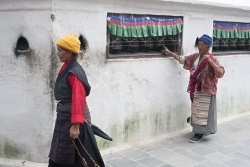Difference between revisions of "The Kora"
(Created page with "thumb|250px| The word ‘kora’ can refer to a path, or the act of walking the path, that surrounds a significant site in Tibetan Buddhism. In our case, ...") |
|||
| Line 1: | Line 1: | ||
[[File:201.jpg|thumb|250px|]] | [[File:201.jpg|thumb|250px|]] | ||
| − | The word ‘kora’ can refer to a path, or the act of walking the path, that surrounds a significant site in Tibetan Buddhism. In our case, kora meant the path around His Holiness’ residence and temple. Tibetans who travel to Mcleod Ganj might walk the path as a sort of pilgrimage, but those who live there use it as a meditative ritual, and some visit it daily. One can walk the kora in whatever fashion he or she pleases, whether while chanting, thumbing mala beads, or simply enjoying the absolutely beautiful atmosphere, as long as you circumambulate clockwise. This becomes obvious when you reach the mantra wheels, which must be turned clockwise in order for the words to appear correctly. But in general, clockwise is always the way to go with Tibetan Buddhist rituals. | + | The word ‘kora’ can refer to a path, or the act of walking the path, that surrounds a significant site in [[Tibetan Buddhism]]. In our case, kora meant the path around His Holiness’ residence and temple. Tibetans who travel to Mcleod Ganj might walk the path as a sort of pilgrimage, but those who live there use it as a meditative ritual, and some visit it daily. One can walk the kora in whatever fashion he or she pleases, whether while chanting, thumbing mala beads, or simply enjoying the absolutely beautiful atmosphere, as long as you circumambulate clockwise. This becomes obvious when you reach the mantra wheels, which must be turned clockwise in order for the words to appear correctly. But in general, clockwise is always the way to go with Tibetan Buddhist rituals. |
| − | Kora path | + | '''Kora path''' |
It’s hard to beat the Himalayan background that greets those walking this peaceful route. The picture above was taken behind us, as clockwise circumambulation would have the side of the hill on our right. | It’s hard to beat the Himalayan background that greets those walking this peaceful route. The picture above was taken behind us, as clockwise circumambulation would have the side of the hill on our right. | ||
| − | Every day we would see Tibetans making their way down the hill to start the kora, as we walked up to teach our classes as Lha. | + | Every day we would see Tibetans making their way down the hill to start the kora, as we walked up to teach our classes as Lha. But sometimes we ourselves would walk it, for stress relief, meditation, or just a pleasant stroll. Along the way are elaborate stone carvings depicting the [[mantra]] “Om mani padme hum” in Tibetan. |
| − | Another major feature of the kora are the prayer wheels. | + | Another major feature of the kora are the prayer wheels. Located on your right hand side, they are large cylindrical objects on an axis that can be spun. In addition to having Tibetan script on their outside, they are actually containers full of hundreds of slips of paper with the mantra written on them. Spinning a prayer wheel accumulates the commensurate merit of reciting all of the mantras inside each wheel. As you walk along the kora, you spin the wheel clockwise while yourself chanting a [[mantra]], thereby coordinating the focus of your thought and action. |
{{R}} | {{R}} | ||
[http://jenniferandcurryinindia.wordpress.com/2012/12/11/the-kora/ jenniferandcurryinindia.wordpress.com] | [http://jenniferandcurryinindia.wordpress.com/2012/12/11/the-kora/ jenniferandcurryinindia.wordpress.com] | ||
Revision as of 16:31, 13 May 2013
The word ‘kora’ can refer to a path, or the act of walking the path, that surrounds a significant site in Tibetan Buddhism. In our case, kora meant the path around His Holiness’ residence and temple. Tibetans who travel to Mcleod Ganj might walk the path as a sort of pilgrimage, but those who live there use it as a meditative ritual, and some visit it daily. One can walk the kora in whatever fashion he or she pleases, whether while chanting, thumbing mala beads, or simply enjoying the absolutely beautiful atmosphere, as long as you circumambulate clockwise. This becomes obvious when you reach the mantra wheels, which must be turned clockwise in order for the words to appear correctly. But in general, clockwise is always the way to go with Tibetan Buddhist rituals.
Kora path
It’s hard to beat the Himalayan background that greets those walking this peaceful route. The picture above was taken behind us, as clockwise circumambulation would have the side of the hill on our right.
Every day we would see Tibetans making their way down the hill to start the kora, as we walked up to teach our classes as Lha. But sometimes we ourselves would walk it, for stress relief, meditation, or just a pleasant stroll. Along the way are elaborate stone carvings depicting the mantra “Om mani padme hum” in Tibetan.
Another major feature of the kora are the prayer wheels. Located on your right hand side, they are large cylindrical objects on an axis that can be spun. In addition to having Tibetan script on their outside, they are actually containers full of hundreds of slips of paper with the mantra written on them. Spinning a prayer wheel accumulates the commensurate merit of reciting all of the mantras inside each wheel. As you walk along the kora, you spin the wheel clockwise while yourself chanting a mantra, thereby coordinating the focus of your thought and action.
